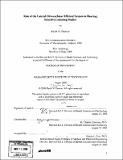| dc.contributor.advisor | M. Charles Liberman. | en_US |
| dc.contributor.author | Darrow, Keith N. (Keith Noble) | en_US |
| dc.contributor.other | Harvard University--MIT Division of Health Sciences and Technology. | en_US |
| dc.date.accessioned | 2007-07-18T13:19:43Z | |
| dc.date.available | 2007-07-18T13:19:43Z | |
| dc.date.copyright | 2006 | en_US |
| dc.date.issued | 2006 | en_US |
| dc.identifier.uri | http://hdl.handle.net/1721.1/37977 | |
| dc.description | Thesis (Ph. D.)--Harvard-MIT Division of Health Sciences and Technology, 2006. | en_US |
| dc.description | Includes bibliographical references (leaves 62-68). | en_US |
| dc.description.abstract | Sensory cells and afferent auditory neurons in the cochlea receive efferent feedback via olivocochlear (OC) neurons originating in the brainstem's olivary complex. The OC system comprises 1) medial (M)OC neurons that decrease electromotility in outer hair cells, and 2) lateral (L)OC neurons that elicit slow excitation or inhibition of auditory nerve dendrites that contact inner hair cells. We investigated the organization and function of the LOC system by immunohistochemical and physiological studies in mice with unilateral stereotaxic destruction of LOC cell bodies. Double immunostaining in control cochleas and brainstems revealed two cytochemical subgroups of LOC neurons: a majority cholinergic population and a minority dopaminergic population. The observation of two LOC subgroups is consistent with reports that LOC activation can either excite or inhibit auditory nerve activity. In lesioned mice, we observed two physiological abnormalities. First, ipsilateral ears were more vulnerable to noise-induced auditory nerve dysfunction, consistent with speculation that dopaminergic transmission controls glutamate excitotoxicity of auditory nerve dendrites after acoustic overexposure. | en_US |
| dc.description.abstract | (cont.) Second, ipsilateral auditory nerve responses were increased while contralateral responses were decreased, and the normal tight correlation of neural excitability between the two ears was disrupted. A neural circuit is proposed to explain bilateral effects from unilateral LOC innervation. We suggest that a key LOC function is to bilaterally balance ascending inputs to olivary complex neurons, which are responsible for computing sound location based on the interaural level differences coded in the response rates of auditory nerve fibers. | en_US |
| dc.description.statementofresponsibility | by Keith N. Darrow. | en_US |
| dc.format.extent | 68 leaves | en_US |
| dc.language.iso | eng | en_US |
| dc.publisher | Massachusetts Institute of Technology | en_US |
| dc.rights | M.I.T. theses are protected by copyright. They may be viewed from this source for any purpose, but reproduction or distribution in any format is prohibited without written permission. See provided URL for inquiries about permission. | en_US |
| dc.rights.uri | http://dspace.mit.edu/handle/1721.1/7582 | |
| dc.subject | Harvard University--MIT Division of Health Sciences and Technology. | en_US |
| dc.title | Role of the lateral olivocochlear efferent system in hearing : selective lesioning studies | en_US |
| dc.title.alternative | Role of LOC efferent system in hearing : selective lesioning studies | en_US |
| dc.type | Thesis | en_US |
| dc.description.degree | Ph.D. | en_US |
| dc.contributor.department | Harvard University--MIT Division of Health Sciences and Technology | |
| dc.identifier.oclc | 150471960 | en_US |
